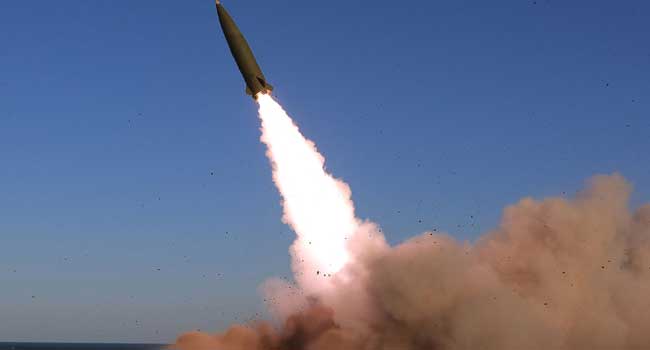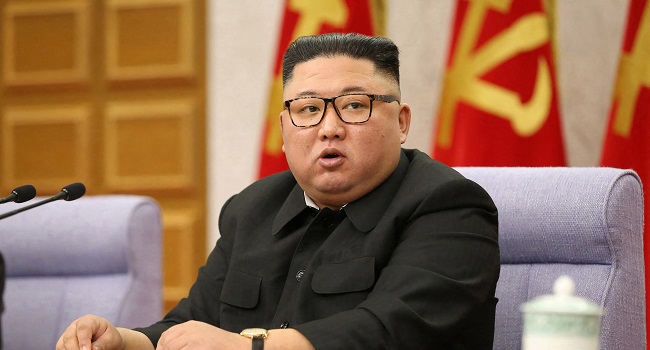
A Hollywood-style trailer US President Donald Trump played for North Korean leader Kim Jong Un at their Singapore summit has received decidedly mixed reviews.
The four-minute film was specially made by the National Security Council for its one-man audience, reports said.
“I thought it was good,” Trump told reporters, adding he showed it to Kim on an iPad. “I think he loved it.”
But many other viewers did not share his enthusiasm.
It was played on big screens ahead of his news conference, Korean version first. “No-one really knew what was going on,” said one photographer in the room. “It felt like a propaganda film by the Koreans.”
But when it was followed by a version with English sound, “it kind of hit us”, he added. “People were quite surprised as to the tackiness of it.”
Opening with a shot of Mount Paektu, the spiritual home of the Korean people and the supposed birthplace of Kim’s father Kim Jong Il, the images rapidly spanned the globe to take in Rome, Egypt and Seoul.
A gravelly voice — straight out of Central Casting — proclaims that out of seven billion people on Earth, “only the very few will make decisions or take actions that renew their homeland and change the course of history”.
Black and white pictures of the Demilitarized Zone that divides the Koreas were followed by images of prosperity — food, a high-speed train, electricity pylons.
“The past doesn’t have to be the future. Out of the darkness can come the light,” the trailer-style voice continues.
“Destiny Pictures presents a story of opportunity.”
But there is a real Destiny Pictures.
“We had nothing to do with Singapore video. Woke up to 100’s of e-mails and calls from all over the world,” tweeted founder Mark Castaldo.
“Now we’re trying 2 find out why they used my company name,” he added. “Crazzzzy day…”
The New York Times made a spoof version of the trailer, its voiceover declaring: “No, really, this actually happened. Trump made a fake movie trailer to deal with an actual nuclear threat.”
The paper’s film critic James Poniewozik said the original had a “totalitarian kitsch” style.
“It’s surreal but it’s no more surreal than the host of the Apprentice negotiating a nuclear deal with North Korea. This is the world we live in now,” he said.
But “in a weird way” it could be appropriate, he added.
“Looking at it objectively as a piece of film and a video being used in diplomacy, it’s kind of hilarious, there’s so many cornball, cliched images. But in political kitsch, often corniness and cliche is the point.”
‘Be the hero’
In the film, the voice proclaims: “Two men, two leaders, one destiny,” to images of Kim and Trump. “A story about a special moment in time, when a man is presented with one chance that may never be repeated.
“What will he choose? To show vision and leadership?” — cue images of Kim’s summit with the South’s Moon Jae-in — “Or not?” — cue fire consuming celluloid film, a metaphor for the destruction of North Korea.
The moment recalled Bergman’s “Persona” or “The Muppet Movie”, wrote Troy Patterson for the New Yorker, slamming the trailer for “its grandiosity, its gaudiness, its chaotic logic, its indiscriminate idiocy”.
As the second half of the movie unfolds, the narrator says, “there can only be two results: one of moving back, or one of moving forward”.
The four missiles the North launched simultaneously in March last year fly back to their pads in reverse, and the dark, electricity-starved half of the Korean peninsula in a satellite photograph light up, railway lines criss-cross a map of the North, and a horse runs through shallow water.
Would the leader “be the hero of his people?” it asked, transliterating Kim’s name into English using South Korean style.
He and Trump were taking part “in a meeting to remake history”, it concluded. “To shine in the sun. One moment. One choice. What if? The future remains to be written.”
Peter Bradshaw, the film critic for Britain’s Guardian newspaper, was scathing.
The Kim family, he pointed out, are movie buffs. Kim’s father and predecessor was a prolific director and kidnapped a top South Korean filmmaker to help develop the North’s moviemaking, said the reviewer, musing that his son “might well be a bit offended by the crudeness of this trailer”.
“We’re getting sold an exciting action-adventure in which the good guys (America) convince the bad guys (North Korea) to come over to the side of decency,” he wrote.
But the film, he added, could be closer to “Wag the Dog”, Barry Levinson’s 1997 satire “about cynical politicos who concoct a big foreign sideshow to distract everyone’s attention from problems on the home front”.
AFP




